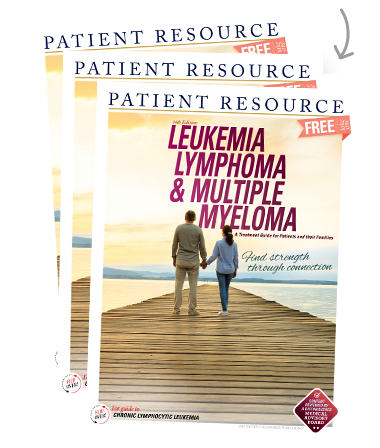Leukemias
Treatment Planning
Some types of blood cancer are curable. Others are managed, with the goal of maintaining a certain quality of life. You will work closely with your doctor to determine the types of treatment that will help achieve your goal. Your doctor will consider many factors, including the stage or classification, type and location of your disease, and your age and general health. You will share your expectations for life during treatment. Together, you will make a plan to move forward.
Following are descriptions of the treatment options that are commonly used. They may be used alone or in combination.
Active surveillance, also called watchful waiting, may be used for slow-growing disease. Regular checkups are necessary for monitoring, and treatment does not begin until test results show the disease is progressing or symptoms appear. This option offers the possibility of avoiding the side effects of treatment for as long as possible and, hopefully, without affecting the outcome.
Drug Therapy
A variety of drugs, alone or in combination, may be used to slow or stop the growth of cancer cells. Ongoing research has resulted in many new drugs and combination therapies that offer the promise of longer and healthier lives for people with blood cancer.
Chemotherapy travels through the bloodstream, affecting cells all over the body. It may be given intravenously (IV) or taken orally as a pill and is typically delivered in cycles, with treatment periods followed by rest periods to give your body time to recover. Strategies may consist of a single chemotherapy drug, a combination given at the same time, or drugs given one after another. Chemotherapy may be used alone or with other forms of treatment, such as stem cell transplantation or chimeric antigen receptor (CAR) T-cell therapy, which is a type of immunotherapy.
Immunotherapy harnesses the potential of the body’s own immune system to recognize and destroy cancer cells. By training the immune system to respond to cancer, this strategy has the potential for a response that can extend beyond the end of treatment. Various types of immunotherapy may be available depending on the diagnosis, such as immune checkpoint inhibitors, cytokines, monoclonal antibodies, personalized vaccines and chimeric antigen receptor (CAR) T-cell therapy. Immunotherapy may be given intravenously (IV) or subcutaneously and may be given in combination with other therapies.
Targeted therapy is a personalized strategy that enables your doctor to use the results from genetic (molecular) testing to target specific genes, proteins, mutations or abnormalities that are causing cancer cells to grow and multiply. Researchers continue to explore the important role these targets play in the growth and survival of cancer cells. New drugs designed to attack these targets have recently been approved, and clinical trials are currently testing others. Unlike chemotherapy, which attacks healthy cells as well as cancer cells, targeted therapy is designed to affect only cancer cells. Targeted therapy drugs may be given orally, subcutaneously or intravenously (IV), and some may be given in combination with other drug therapies.
Corticosteroids are drugs used to treat some blood cancers and can ease nausea and vomiting. They can be used alone or in combination with other types of drug therapy and are given orally or through an IV.
Growth factors help the body make white blood cells and are given because white blood cells are often damaged by treatment, which can increase the risk of infection.
Bone-modifying drugs are given by IV to treat bone problems as well as prevent or slow further bone damage. Pain medications are sometimes added to control bone pain.
Stem Cell Transplantation
Also known as bone marrow transplantation, a stem cell transplant involves an infusion of healthy stem cells into the body, typically after chemotherapy (see Stem Cell Transplantation).
Radiation Therapy
Radiation therapy is designed to destroy cancer cells and shrink tumors with high-energy radiation. Localized blood cancer or bone pain that does not lessen with chemotherapy may be treated with radiation therapy targeted to specific parts of the body. External-beam radiation therapy (EBRT), which aims high-energy rays at the cancer from outside of the body, is commonly used. EBRT may be given to the entire body before stem cell transplantation to make space to allow for the new cells (graft) to replace the diseased blood system.
Surgery
Surgical procedures may be done to take a biopsy sample or, in cases of weakened bone, to place metal plates or rods that provide support or prevent fractures. Though surgery is not common for treating blood cancers, it may be used to remove a single plasmacytoma (malignant plasma cell tumor), which can occur with multiple myeloma, or to remove the spleen or other organs for certain subtypes of non-Hodgkin lymphoma.
Clinical Trials
These medical research studies are important to consider when discussing treatment options with your doctor. Treatment trials evaluate whether a new treatment, such as a drug or vaccine, drug combination, surgical procedure, type of radiation therapy or a combination of therapies, is more effective or better in some way than the current standard of care. Depending on your diagnosis and other factors, the therapy used in a clinical trial may be suitable as a first-line treatment (before any other treatment is given) or at another time during care.



